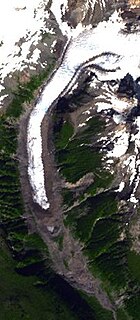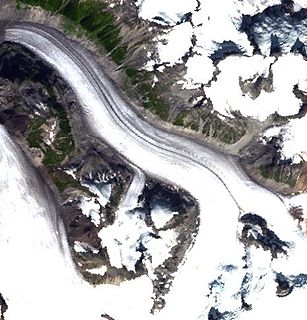Kingcome Inlet is one of the lesser principal fjords of the British Columbia Coast, north and east of Broughton Island. It is sixth in sequence of the major saltwater fjords north from the 49th parallel north near Vancouver and similar in width to longer inlets such as Knight Inlet and Bute Inlet, but it is only 35 km in length from the mouth of the Kingcome River to Sutlej Channel, which ultimately connects around Broughton Island to the main regional waterway of the Queen Charlotte Strait. Kingcome Inlet has a short side inlet, Wakeman Sound, fed by the Wakeman River.
Kwikwasut'inuxw Haxwa'mis, formerly the Kwicksutaineuk-ah-kwa-mish First Nation is a First Nations band government based on northern Vancouver Island in British Columbia, Canada, in the Queen Charlotte Strait region. It is a member of the Musgamagw Tsawataineuk Tribal Council, along with the ‘Namgis First Nation and the Tsawataineuk First Nation. The Kwikwasut'inuxw and Haxwa'mis are two of the many subgroups of the peoples known as Kwakwaka'wakw, which means "speakers of Kwak'wala", their language, and were combined into one band by the Department of Indian and Northern Affairs.
Kingcome, known as Gwa'yi in Kwak'wala, is an unincorporated settlement in the Kingcome Inlet area of the Central Coast of British Columbia, Canada, located a few miles up the Kingcome River from the head of the inlet. Quaee Indian Reserve No. 7 is the Indian reserve containing the village.
The Kingcome River is a river in the Canadian province of British Columbia. Its drainage basin is 1,456 square kilometres (562 sq mi) in size.

The Kingcome Glacier is a glacier located at the head of the Kingcome River in southwestern British Columbia, Canada.

The Pashleth Glacier is a glacier south of the Machmell River and west of the Klinaklini Glacier in southwestern British Columbia, Canada.
Simoom Sound is a sound on the Central Coast of British Columbia, Canada, located on the east and north sides of the Wishart Peninsula between Tribune Channel and Kingcome Inlet. The former steamer landing and current post office of Simoom Sound. The former steamer landing, now classified as a "locality" and the post office of Simoom Sound, British Columbia is named for the sound, which is located at Echo Bay on Gilford Island. Kawages Indian Reserve No. 4 is located on the north side of Simoom Sound and is a reserve of the Dzawada'enuxw First Nation of the Kwakwaka'wakw peoples.
Wakeman Sound is a sound on the South Coast of British Columbia, Canada, located in the area north of the Broughton Archipelago, which lies on the north side of Queen Charlotte Strait, on the northeast side of Broughton Island. It is a sidewater opening of and opening north off Kingcome Inlet.
Hopetown is an Indian Reserve community of the Gwawa'enux group of Kwakwaka'wakw peoples, located on the south side of Watson Island, to the north of Broughton Island in the Broughton Archipelago on the north side of the Queen Charlotte Strait region on the Central Coast of British Columbia, Canada. The community is located entirely within Hopetown Indian Reserve No. 10A. The traditional name of the village in the Kwak'wala language is Hikums, which has also been spelled Hegams and Hakina and Hegams, meaning "facing outwards".
Pekw'Xe:yles or Peckquaylis is an Indian Reserve on the north bank of the Fraser River in Mission, British Columbia, Canada, located between Lower Hatzic Slough and D'Herbomez Creek. 10.3 ha. in area, it was reinstated in June, 2005 by Order in Council and is used by 21 Indian bands.

Kingcome Inlet is a locality on the Central Coast region of British Columbia, located on the inlet of the same name.
Shawl Bay, British Columbia, Canada, is a bay and locality on the west side of the Wishart Peninsula, which is to the east of Broughton Island, in the Inside Passage between Vancouver Island and the British Columbia mainland near the entrance to Kingcome Inlet. The bay is located between the Wishart Peninsula to the east and Gregory Island to the west; the locality is located on the east side of the bay on a small isthmus at 50°51′20″N126°33′20″W which forms the Wishart Peninsula. It can be approached from Penphrase Passage from the east, or Sutlej Channel from the west. There is a commercial marina at this location serving pleasure boaters.
Bond Sound is a sound located on the northeast side of Tribune Channel in the Central Coast region of British Columbia. Bond Sound, with the head of Kingcome Inlet to its north, frames the Wishart Peninsula. Like other names in the area, it was named by Captain Pender in 1865, in association with other names in the area associated with HMS Tribune.
The Ahta River is a river in the Central Coast of British Columbia, flowing into Bond Sound to the south via the short Ahta Valley, which connects to the head of Kingcome Inlet to the north.

Prospect Point is a point at the northern tip of Stanley Park in Vancouver, British Columbia, Canada, located on the south side of the First Narrows of Burrard Inlet. The point, which as its name suggests, is a viewpoint, landmark and tourist attraction in Stanley Park and has a restaurant and other facilities, is just west of the Lions Gate Bridge.
The Kingcome Range is a subrange of the Pacific Ranges of the Coast Mountains, located to the east of Kingcome Inlet.
The Wakeman River is a river in the western Pacific Ranges on the Central Coast region of British Columbia, Canada, flowing south into Wakeman Sound, which is a sidewater of Kingcome Inlet.
Waluk was a Kwakwaka'wakw village of the Tsawataineuk group located at Anchorage Cove on the south shore of the head of Kingcome Inlet in the Central Coast region of British Columbia, Canada. The site was used for timber harvesting, fishing and trapping.
The Atlatzi River is a river in the Pacific Ranges in the Central Coast region of British Columbia, Canada, flowing southwest into the lower Kingcome River, which feeds the head of Kingcome Inlet. It had been called Back River on a 1919 map of British Columbia. Its headwaters are at 51°03′N125°52′W.
The Clear River is a river in the Central Coast region of British Columbia, Canada, flowing east out of the Pacific Ranges of the Coast Mountains into the Kingcome River, of which it is a tributary. Other tributaries of the Kingcome are the Atlatzi and the Satsalla.







